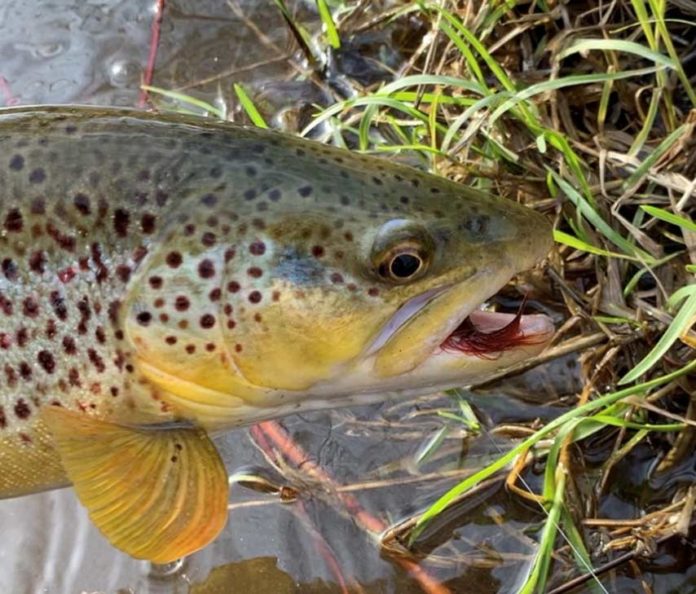Written by: Phil Monahan
That Saturday was a glorious day in Southwestern Vermont, as temperatures climbed into the low 60s, and we had some bright sunshine. I checked the USGS river gauge for the Battenkill and saw that flows had finally dipped below 1,000 CFS, which meant that one of my favorite early-season spots–luckily, just five minutes from my house–would be safe to wade for the first time that season. I hit the water at about 5 p.m. and discovered that, while wading wasn’t a problem, getting a good streamer presentation would be a challenge.
In this stretch, the river flows over a shallow, rocky ledge into a deep pool, which transitions to a long flat of waist-deep water. I knew from experience that the inside of the deep hole would be great when Hendrickson spinners started dropping–still a couple weeks away–but otherwise the fish would be on the flat. The main current was racing against the far bank, so I suspected that trout would be holding just on my side of the heavy flow. The trick was getting a streamer to these fish, deep enough for them to see it and want to chase.

Starting with a floating line, I tied a black Conehead Woolly Bugger to the end of a 9-foot 2X leader, and then attached 18 inches of 3X to the hook bend and added a brown DDH Leech–one of my favorite patterns. I chose both patterns because they work well dead-drifted and swung, which helps when you’re employing what I call the “sink-and-swing” presentation. It’s really just a streamer version of the classic Leisenring Lift, and I like it for three reasons: It allows you to get your flies very deep, trout will sometimes eat during the drift, and it allows you to pinpoint the spot where the flies start to swing. Here’s how I do it.
- Cast quartering upstream, dropping your flies directly into the heaviest current.
- If possible, “high-stick” the drift, keeping as much fly line off the water as you can, until the tip of your line is directly across from you. If you’re too far away to high-stick, proceed to #3.
- Start throwing roll-cast mends directly upstream of the tip of the fly line, to feed slack into the drift. This allows the flies to continue sinking.
- When the tip of the fly line is 10 feet upstream of your target, start making short strips to pull the flies off the bottom and swing them through the lie.
There’s a little bit of trial-and-error involved in this presentation, as you figure out how far upstream you need to cast to get your flies deep enough but not so deep that they hang up on the bottom. One of the things I love about the sink-and-swing is that you can alter the second half of the presentation in myriad ways to make the flies dart across current, swing under tension, or anything in between. I also change up the length and frequency of my strips to see what draws a strike.

On about my twentieth cast, just as the flies swung out of the main current, I felt a good thump. I came tight to the fish and got it on the reel, but I couldn’t yet tell what I was connected to. Then a brownish-yellow slab thrashed for a moment on the surface, and I realized it was a very nice trout. Using side pressure, I was able to maneuver it out of the heaviest current and finally landed it along a grassy bank. I didn’t measure the fish, but it was surely the biggest brown I’d caught from the Battenkill in several years.
My two largest Battenkill browns have been caught with this sink-and-swing technique, and I’ve used it to good effect on rivers in other parts of the country, as well. If a fish does eat on the dead-drift, you need to employ a sweep set to your downstream side to use the line on the water to set the hook. So give it a try the next time you suspect that your streamer presentation isn’t getting deep enough or if you’re finding it difficult to put your flies right where you want them.
Phil Monahan is the editor of the Orvis Fly Fishing blog. He was at the helm of American Angler magazine from 1998 to 2008.
Credit: Source link






























